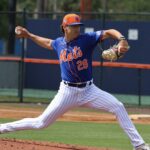
When all things are considered normal — you know, when we’re not living in the presence of a global pandemic — there’s quite a bit of player movement that goes on with Major League Baseball teams. There are those certain occasions where stars come along and man a position for a number of consecutive years in the same city, but it’s becoming less frequent.
Heck, even superstars that one would imagine are safe in one spot after getting a big extension — Nolan Arenado is one example — run the risk of seeing their names in the rumor mill at any given time. It’s just the way teams work these days as they constantly look for ways to not only improve, but in some cases, become more efficient or “financially flexible”.
As I stared out the window wishing life was back to some sort of normalcy and baseball was happening again, the New York Mets’ shortstop position popped into my head. Obviously, Amed Rosario has manned that spot for the last two-plus seasons, and while it’s been slow, the 24-year-old’s growth has been an encouraging sight.
Don’t ask me how I started thinking about the Mets’ recent past at the position — let’s just blame no baseball or sports to occupy us — but I realized that while there hasn’t been a long and continuous run by one player in particular (when accounting for injuries and whatnot), shortstop has been a position handled by mostly homegrown players. This is especially the case when looking back on New York’s recent past, and for the purposes of today, “recent past” creeps all the way back to 1996.
When qualifying as the position being mostly homegrown in any given year, I utilized the Ultimate Mets Database to see which player led the squad in games played at shortstop.
The Homegrown Shortstops
Since it’s not exactly a short list, here’s a quick table detailing all the homegrown Mets to lead the team in games played at shortstop since 1996. The table also includes the years in which those occurrences took place, and their total games played at shortstop in Flushing (with the rank in parenthesis):

When looking at what we see above, it’s obvious that the homegrown shortstops have been more of a revolving door in recent years than at the beginning of this arbitrary period of time. If it wasn’t for a broken left arm in 2000, Rey Ordonez would’ve been at the top of the games played list for eight consecutive years.
He was incredibly fun to watch with the glove, but phew, I forgot how much of a black hole he was in the lineup on most days. Through 3,216 plate appearances with New York, he slashed .245/.290/.304 with eight home runs, 260 RBI, and 275 runs scored, which all sussed out to a .259 wOBA and 53 wRC+. Even with the sparkling defense, he was worth 2.4 fWAR overall.
Jose Reyes‘ mark on Mets franchise history is easy to see, and his run on top of the shortstop games played leaderboards would’ve been consecutive between 2003 and 2011 if it wasn’t for a silly move to second base one year and injury in another.
The Acquired Dudes
The below table is a nice little jaunt down memory lane, now isn’t it?

Remember when Kazuo Matsui came over from Japan and actually led to Reyes getting pushed to second base for a year? Glad that idea didn’t stick around for very long. I was also reminded that Kaz was part of the 2006 Mets for a short period of time — it wasn’t at all pretty, of course. In just 139 plate appearances and 38 games played, he managed to muster a .200/.235/.259 line, leading to a 26 wRC+ and -0.3 fWAR.
New York ended up trading him and $4.5 million to the Colorado Rockies for Eli Marrero, which also opened the door for Jose Valentin to become the surprise every-day second baseman for the National League East champions.
In his tenure as Mets general manager, signing Asdrubal Cabrera was definitely one of the best things Sandy Alderson ever did. Cabrera had a productive two-plus years with New York, and 2016 was easily his best overall. Through 568 plate appearances, he slashed .280/.336/.474 with 23 home runs, 62 RBI, and 65 runs scored. That led to a 120 wRC+ and 3.6 fWAR.
He was also part of a memorable tear down the stretch once he and Yoenis Cespedes returned from the injured list that August, helping the Mets host the NL Wild-Card play-in game. From August 19th through the end of the regular season (165 plate appearances), Cabrera posted a 180 wRC+ off the strength of a .345/.406/.635 triple slash. He collected 10 homers and 29 RBI during this period of time, along with one bat flip that will be replayed at Citi Field for years to come:
Future Is Looking Similar
While it’s uncertain how real his talks were in either instance, general manager Brodie Van Wagenen tried to trade for Carlos Correa and Francisco Lindor at different times this past winter. Despite those efforts, Rosario remains locked in as the every-day shortstop for the third consecutive year, and the Mets hope he’ll continue progressing both at the plate and in the field.
Although Rosario is only 24 years old and isn’t even arbitration-eligible yet, there are already some guys in the minors that could eventually take his spot. Those dudes are Andres Gimenez (MLB ETA of 2020) and Ronny Mauricio (MLB ETA of 2022, per MLB Pipeline).
Regardless of the direction New York plans on taking within the next couple years, it at least seems likely that shortstop will remain a mostly homegrown position. So, the trend that’s appeared here looks to have some life moving into the future.















